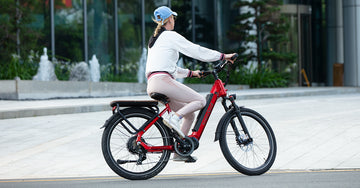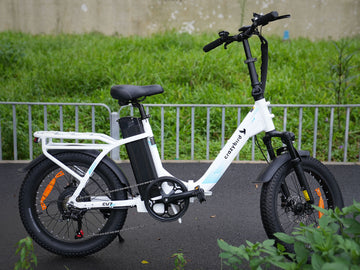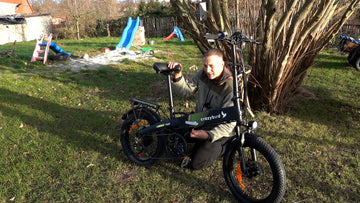It can be scary to
ride an electric bike for the first time on the road, particularly if you've never done it at rush hour. Your commutes will be quicker, shorter, and much healthier if you can get the hang of it.
Bicycling has many benefits, including heart health improvements and ensuring you get the daily necessary amount of vitamin D. Many of us are aware that riding a bike instead of a car or bus can make us happier and healthier, but planning ahead and traffic can be big barriers to cycling. Even in situations where we have no control over the weather or traffic, we can still take various precautions to stay safe and ensure a comfortable arrival. These are our top suggestions for gaining confidence in cycling in light of this.
Are You Aware of Your City's Riding Signals?
Get familiar with the driving regulations if you don't already! Understand the turn signal. Find out what your city's rights are; is there a three-foot rule? Are all roads where you can use the lane unrestricted?
In France, most urban and rural roads, bike lanes, shared roads, and dedicated bicycle routes are all open to traffic. There are dedicated bike lanes in many cities, including Bordeaux, Lyon, and Paris, which make it easier and safer for bicycles to cross busy streets. There are, nevertheless, some restrictions. For safety concerns, electric bicycles, like conventional bicycles, are typically not allowed to ride on highways. Furthermore, in order to safeguard the environment or the pedestrian experience, some natural regions, historical sites, and pedestrian districts may limit or regulate bicycle traffic.
Electric bikes are governed by the same laws and regulations as conventional bicycles in the United Kingdom. This indicates that they are not permitted to ride on side walks but are permitted to ride in bike lanes, car lanes, and roads. The same traffic laws that apply to riders of conventional bicycles also apply to riders of e-bikes, including stopping at stop signs and red lights and turning with gestures.
In German, it is advised to ride in the designated bicycle lane to prevent collisions and fines. Additionally, a bike lane is designated with a bicycle diagram and has a curb to separate it from the main road. It seems like an extension of the pavement, but has a different pattern or colour. The right side is where cyclists should ride. If there isn't a designated bike lane on a road, keep your bike close to the curb. Always maintain an arm's-length gap between you and the parked cars. Always ride in a single lane if you are cycling in one designated for bicycles. Never travel in tandem. Please use your right hand to indicate that you wish to turn right. Make a left-hand signal to indicate in the left direction. Make sure to provide a stop indication if you have to abruptly interrupt your cycle. The hand signal for pausing is a downward extension of one arm.
The Reason for Cyclists' Fears
Our brain's natural tendency is to scan for threats. The amygdala, often known as your inner chimp, is a unique component of it that keeps us vigilant and activates when we find ourselves in danger.
-
Lots of Cars are on the Road
Getting struck by a car is the greatest fear of all. There are loads of cars to deal with everywhere, even though many cyclists are adding gravel bikes to their arsenals in an effort to spend less time on pavement. Try to imagine how anxious you may feel when there are a lot of vehicles behind you and you are unfamiliar with the local driving laws.
-
Steep Downhills
I enjoy travelling downhill. Free speed is awarded for overcoming obstacles to reach the summit of the slope. However, many riders find steep descents frightening, and as a result, they ride the brakes the entire way down, which is an unpleasant feeling.
-
Meet the Bad Weather
There won't be a pleasant location nearby when you work out in the outdoors in case it starts to rain, hail, or snow, the wind speeds up, or lightning strikes. Additionally, it is not a good idea to ride a bicycle with an umbrella in one hand.
-
Attacks by Animals
The most frequent issue that cyclists have with animals is being pursued by dogs, but this is by no means the only one. An animal that suddenly charges at you from a particular direction could startle you, make it difficult for you to move on for a while, or even create psychological shadows.
-
Individual Experience
In my early years, my older brother and I rode a bicycle together—one of us sat on the top tube, the other on the
bike back seat—and as we went uphill, I heard my younger brother sobbing. We later discovered that his right foot had rolled into the bicycle wheel, which had rendered him unable to stand for a month.
How to Overcome the Fears
Cycling requires confidence, and developing it will improve your riding and increase your safety. Also, since you'll be riding your bike less anxiously, it will increase the enjoyment of your cycling adventures. Here are some suggestions to increase your confidence when riding a bike, whether it's because you're scared to go down hills, ride in traffic, or just can't go the distance.
A helmet can literally save your life. Helmets are an essential item because they provide more than just protection from oncoming traffic. At 20 miles per hour, cycling equals jumping out of a second-story window at your top speed. Without a helmet, it can be very dangerous to lose your balance or get your wheel trapped in a pothole.
At first, riding a bicycle through a city can be frightening, but you can get over your fear by learning how to use the roads at calm times. Sundays often see less traffic and fewer cabs than other days. Schedule a time to give it a try one Sunday morning. If you depart early, there will be less traffic on your routes.
Please refer to the local traffic legislation before buying an electric bicycle to determine the proper turning and stopping gestures. This will help you stay safe and prevent accidents. Knowing the terrain and route of the new location is essential for self-defence.
Given that the majority of our readers are far beyond the beginner's stage, safety should always come first, so make sure you get high-quality
bike light, and use helmets when appropriate. You can plan your bike trip so that it avoids all roads, but you won't want to put yourself in a bind for too long because riding a bike becomes really comfortable. Ultimately, cycling through the backstreets on a fresh root is a great opportunity to see the city from a different angle.














